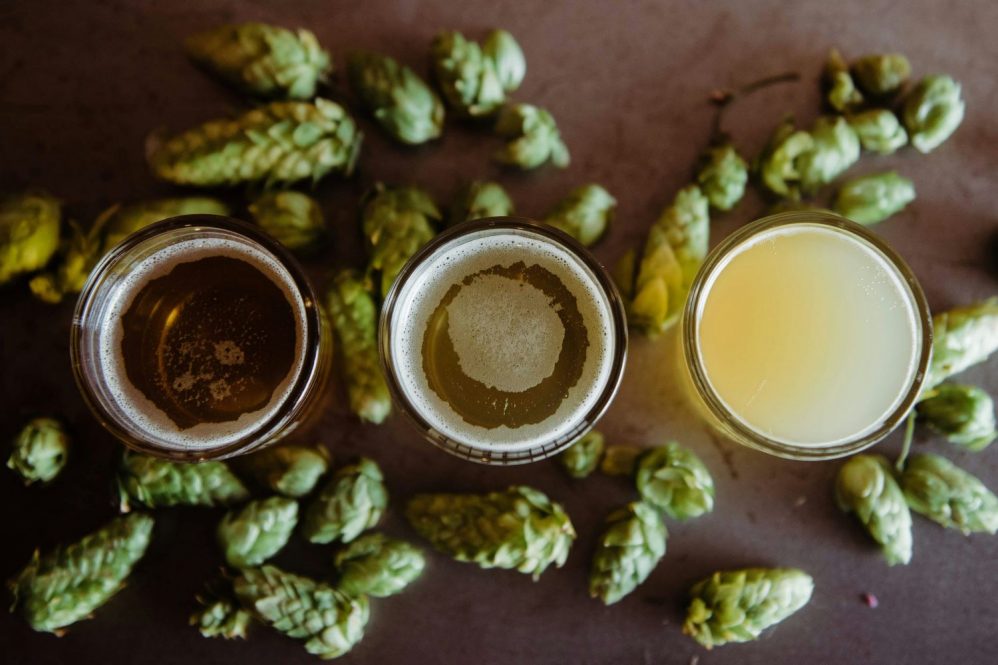As part of UConn’s new Brewing Innovation Initiative, a collaborative effort between UConn faculty, staff, students, and local breweries in the state, the College of Agriculture, Health and Natural Resources (CAHNR) is helping bolster the craft brewing industry in the state with expertise related to hops. The initiative was officially announced at an event at Kinsmen Brewing in Milldale on Nov. 28.
Hops are the green, cone-shaped flowers of the Humulus lupulus plant. They give certain beers, like IPAs, their distinctive bitter flavor.
There are currently about 120 local commercial craft breweries in Connecticut. CAHNR is expanding its research and outreach efforts to include this industry and local hops farmers in their work.
Srikanth Kodati, a UConn Extension educator for pesticide safety education and crop protection, will lay out some important information about growing hops in Connecticut.
What is the history of hops farming in Connecticut?
It goes back to the 16th century. The Northeast was a region where we grew a lot of hops. But due to diseases and pests, as well as Prohibition in the 20th century, hops production moved to the Pacific Northwest. Now about 95% of hops grown in the U.S. come from the Pacific Northwest, in states like Washington, Idaho, and Oregon. There has been a huge demand to rebuild hops production in the northeastern region in the last 10 years. Just like we have seen in other food products, there is an increasing demand for local breweries and local flavors. So that’s why there is rapid interest in the growing of hops locally.
How are hops grown?
Hops are grown in two different ways, with high trellises and low trellises. There was a study that showed there is no significant difference in the labor requirement between the high and low trellis systems. But the quantity of production is 50-100% lower with the low trellis, so, the high trellises are suggested. The only barrier is that you need specialty equipment that can work at that height and that’s very expensive in the beginning. So, there will be a high input cost.
How are hops used in brewing?
Hops can be used in two different ways: wet hopping and dry hopping. Wet hopping is when you add the fresh, green hop cones immediately after harvest in the brewing process; it gives the beer that signature bitterness. And if you add the hops in the later stages (dry hopping), it gives flavor and aroma to the production.
Hops have different cultivars, and they will give different flavors to the beer. There are three different kinds of hops – aroma hops, bittering hops, and “dual-purpose” hops which can add both bitterness and aroma to a brew. Adding different cultivars in different combinations will change the aroma and the bitterness of the beer. That’s called hops profiling.
What are the advantages of growing hops in Connecticut?
One of the major advantages of being in the northeast is the climate. The climate is very suitable for hops production. This climate resembles the climate of European countries where hops are grown. In the peak season, we have 16 hours of daylight, so that is very suitable. So that is the biggest opportunity for Northeast farmers. And we have a lot of local breweries in the metropolitan areas around Connecticut, in New York and Massachusetts. These places are going to be the hubs for local brewery production.
What are the major challenges for hops growers in Connecticut?
The main concern is diseases like mildew – downy mildew and powdery mildew. These diseases are dependent on weather conditions. The active growing period – usually around July and August – is when hops are most susceptible to pests like powdery mildew and leaf hoppers.
Another challenge is the cost of production, and that depends on many factors. For example, the limited supply of barley. A lot of barley comes from Ukraine. Because of the war, there is an increase in the cost of production. Other resources, like land, are very expensive in the Northeast – to have viable hops production you need at least 10 acres of land. So, these are all factors brewers need to consider.
What kind of hops research will UConn conduct?
There is limited information about the performance of existing hops cultivars specific to the soil and environmental conditions in our region, and it is well known that those factors can have a significant impact on flavor. Research at UConn will address the entire production pipeline, from development of new plant genotypes, identifying native yeast strains for fermentation, to strategies for optimal yield and growth, all focused in some part on the production of high-quality beer. As a plant pathologist, I anticipate that as new cultivars are grown in this region that there will be challenges with pests and diseases. We can examine the existing tools, disease forecasting models, and techniques developed for other regions and establish science-based information to validate their application in our region to enable optimal growth, production, and yield. At UConn, we have existing research and tools to be able to develop a deeper understanding of biochemical pathways in the hops plant that are involved with flavor generation, such as the quality and quantity of alpha acids and essential oils. That, combined with our existing capacity and abilities to develop genetic tools for non-GMO modification of hops cultivars, is poised to expedite development of hops cultivars specific and unique for our region.
This work relates to CAHNR’s Strategic Vision area focused on Ensuring a Vibrant and Sustainable Agricultural Industry and Food Supply.
Follow UConn CAHNR on social media



